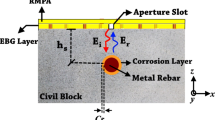Abstract
The existence of moisture in concrete is a major cause of damage to the concrete structure, so there is an increasing need for nondestructive detection and monitoring of moisture content in concrete. Microwave nondestructive testing (MNDT) techniques have advantages over other NDT methods (such as radiography, ultrasonic, and eddy current) regarding low cost, good penetration in nonmetallic materials, good resolution and requirement of only one face of material for testing. In this paper, microwave open-ended rectangular waveguide was used to measure the electromagnetic properties of Portland cement concrete (PCC) over a frequency range of 7.0 to 13.0 GHz. PCC specimens of six different water cement ratio (w/c) were prepared. PCC dielectric properties were evaluated at different moisture content ranges from saturated to oven dry. The results show reflection coefficients, dielectric constants and loss factors increase with increasing moisture content of PCC. At the same values of moisture content, the reflection coefficients, dielectric constants and loss factors of PCC increase with decreasing w/c ratio. The measured values of reflection coefficients, dielectric constants and loss factors can be used to determine the moisture content of PCC.
Similar content being viewed by others
References
Fromm, H.J., 1974, The mechanism of asphalt stripping from aggregate surfaces: Proceeding Association Asphalt Paving Technologists, v. 43.
Steinway, W.J., Echard, I.D., and Luke, C.M., 1981, Location of voids beneath pavement using pulsed electromagnetic waves: NCHRP 237.
Ghodgaonkar, D.K., Varadan, V.V., and Varadan, V.K., 1989, Free-space method for measurement of dielectric constants and loss tangents at microwave frequencies: IEEE Transactions on Instrumentation and Measurement, v. 38, p. 789-793.
Al-Qadi, I.L., Ghodgaonkar, D.K., Varadan, V.K., and Varadan, V.V., 1991, Effects of moisture on asphaltic concrete: IEEE Transactions on Geoscience and Remote Sensing, v. 29, p. 710-717.
Ghodgaonkar, D.K., Majid, W.M.B.W.A., and Majid, R.B.A., 1999, Accurate measurement of electromagnetic properties of concrete for nondestructive evaluation at microwave frequency, concrete durability and repair technology, University of Dundee International Congress, Scotland (UK), September 8-10, p. 673-679.
Bois, K.J., Benally, A.D., Nowak, P.S., and Zoughi, R., 1998, Cure-state monitoring and water-to-cement ratio determination of fresh Portland cement based materials using near-field microwave techniques: IEEE Transactions on Instrumentation and Measurement, v. 47, p. 628-637.
Zoughi, R., Gray, S., and Nowak, P.S., 1995, Microwave nondestructive estimation of cement paste compressive strength: ACI Materials Journal, v. 92, no. 1, p. 64-70.
Bois, K., Benally, A., and Zoughi, R., 2000, Microwave near-field reflection property analysis of concrete for material content determination: IEEE Transactions on Instrumentation and Measurement, v. 49, no. 1.
Decreton, M.C. and Gardiol, F.E. 1974, Simple nondestructive method for the measurement of complex permittivity: IEEE Transactions on Instrumentation and Measurement, v. 23, p. 434-438.
Galejs, K., 1965, Admittance of a waveguide radiating into stratified plasma: IEEE Transactions on Antennas and Propagation, v. 13, p. 64-70.
Baily, M.C. and Crosswell, W.F., 1982, Antennas in Electronics Engineers Handbook, D.G. Fink and D. Christiansen, eds., McGraw-Hill Book Co., New York.
Ghodgaonkar, D.K., 1987, Measurement of complex permittivities of biological materials and human skin in vivo in the frequency range of 26.5-60 GHz, Ph.D. dissertation, Department of Electrical Engineering, University of Utah, Salt Lake City, UT, p. 60-89
WILTRON, 1996, Vector Network Analyzer, WILTRON 37269B Manual.
Von Hippel, A., 1954, Dielectric materials and applications, Artech House, Boston, MA, p. 361-362.
Al-Mattarneh, H.M.A., 2000, Electromagnetic properties of Portland concrete using microwave nondestructive testing techniques, M.Sc. dissertation, Faculty of Civil Engineering, MARA University of Technology, Shah Alam, Selangor, Malaysia.
Author information
Authors and Affiliations
Corresponding author
Rights and permissions
About this article
Cite this article
Al-Mattarneh, H.M.A., Ghodgaonkar, D.K. & Majid, W.M.B.W.A. Microwave Sensing of Moisture Content in Concrete Using Open-Ended Rectangular Waveguide. Subsurface Sensing Technologies and Applications 2, 377–390 (2001). https://doi.org/10.1023/A:1013217017554
Issue Date:
DOI: https://doi.org/10.1023/A:1013217017554




